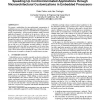Free Online Productivity Tools
i2Speak
i2Symbol
i2OCR
iTex2Img
iWeb2Print
iWeb2Shot
i2Type
iPdf2Split
iPdf2Merge
i2Bopomofo
i2Arabic
i2Style
i2Image
i2PDF
iLatex2Rtf
Sci2ools
DAC
2001
ACM
2001
ACM
Speeding Up Control-Dominated Applications through Microarchitectural Customizations in Embedded Processors
We present a methodology for microarchitectural customization of embedded processors by exploiting application information, thus attaining the twin benefits of processor standardization and applicationspecific customization. Such powerful techniques enable increased application fragments to be placed on the processor, with no sacrifice in system requirements, thus reducing the custom hardware and the concomitant area requirements in SOCs. We illustrate these ideas through the branch resolution problem, known to impose severe performance degradation on control-dominated embedded applications. A low-cost late customizable hardware that uses application information to fold out a set of frequently executed branches is described. Experimental results show that for a representative set of control dominated applications a reduction in the range of 7%-22% in processor cycles can be achieved, thus extending the scope of low-cost embedded processors in complex co-designs for control intensive s...
Concomitant Area Requirements | DAC 2001 | Design Automation | Enable Increased Application | Low-cost Embedded Processors |
Related Content
| Added | 13 Nov 2009 |
| Updated | 13 Nov 2009 |
| Type | Conference |
| Year | 2001 |
| Where | DAC |
| Authors | Peter Petrov, Alex Orailoglu |
Comments (0)

